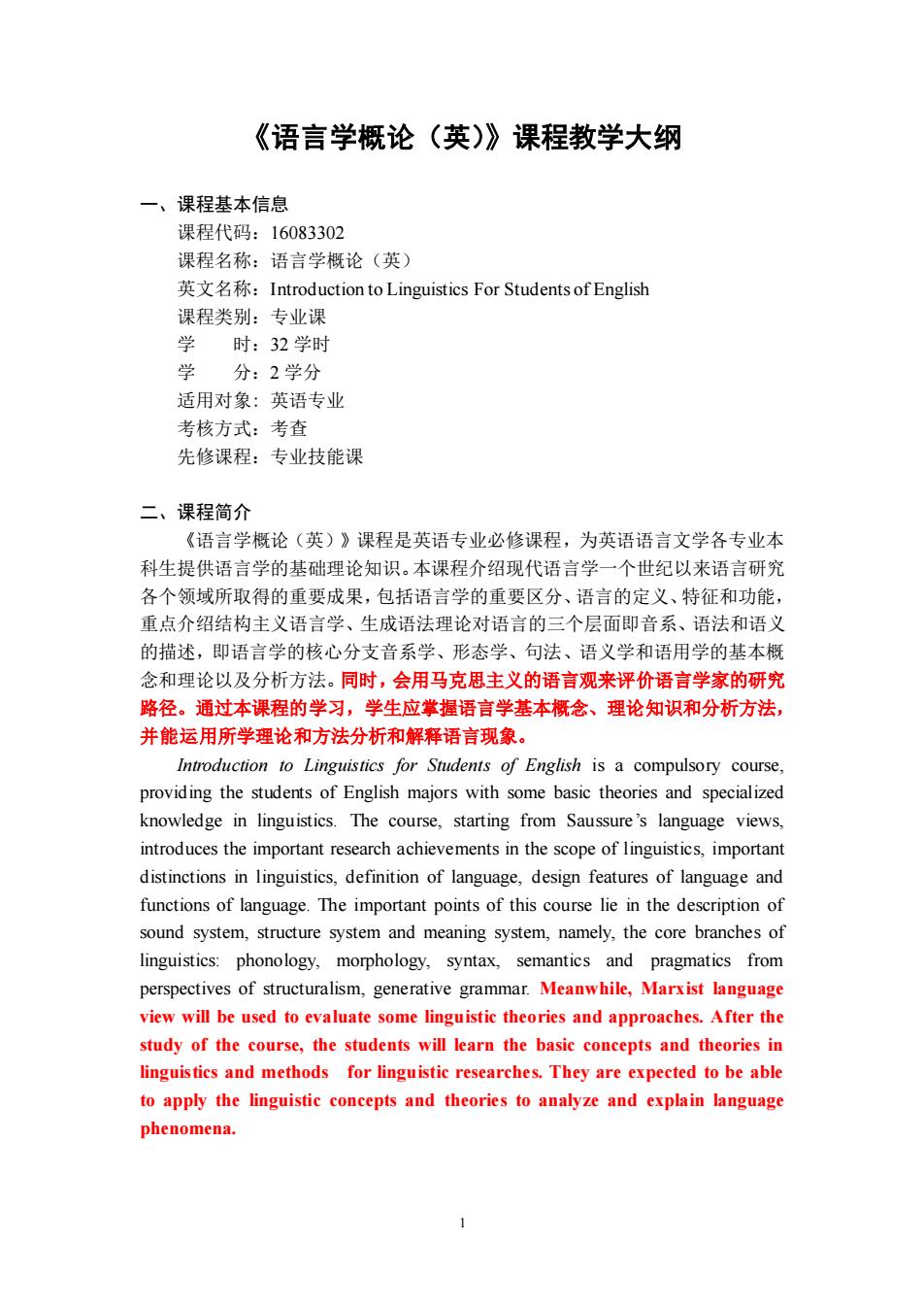
《语言学概论(英)》课程教学大纲 一、课程基本信息 课程代码:16083302 课程名称:语言学概论(英) 英文名称:Introduction to Linguistics For Students of English 课程类别:专业课 学时:32学时 学 分:2学分 适用对象:英语专业 考核方式:考查 先修课程:专业技能课 二、课程简介 《语言学概论(英)》课程是英语专业必修课程,为英语语言文学各专业本 科生提供语言学的基础理论知识。本课程介绍现代语言学一个世纪以来语言研究 各个领域所取得的重要成果,包括语言学的重要区分、语言的定义、特征和功能, 重点介绍结构主义语言学、生成语法理论对语言的三个层面即音系、语法和语义 的描述,即语言学的核心分支音系学、形态学、句法、语义学和语用学的基本概 念和理论以及分析方法。同时,会用马克思主义的语言观来评价语言学家的研究 路径。通过本课程的学习,学生应掌握语言学基本概念、理论知识和分析方法, 并能运用所学理论和方法分析和解释语言现象。 Introduction to Linguistics for Students of English is a compulsory course. providing the students of English majors with some basic theories and specialized knowledge in linguistics.The course,starting from Saussure's language views, introduces the important research achievements in the scope of linguistics,important distinctions in linguistics.definition of language.design features of language and functions of language.The important points of this course lie in the description of sound system,structure system and meaning system,namely,the core branches of linguistics:phonology,morphology,syntax,semantics and pragmatics from perspectives of structuralism,generative grammar.Meanwhile,Marxist language view will be used to evaluate some linguistic theories and approaches.After the study of the course,the students will learn the basic concepts and theories in linguistics and methods for linguistic researches.They are expected to be able to apply the linguistic concepts and theories to analyze and explain language phenomena
1 《语言学概论(英)》课程教学大纲 一、课程基本信息 课程代码:16083302 课程名称:语言学概论(英) 英文名称:Introduction to Linguistics For Students of English 课程类别:专业课 学 时:32 学时 学 分:2 学分 适用对象: 英语专业 考核方式:考查 先修课程:专业技能课 二、课程简介 《语言学概论(英)》课程是英语专业必修课程,为英语语言文学各专业本 科生提供语言学的基础理论知识。本课程介绍现代语言学一个世纪以来语言研究 各个领域所取得的重要成果,包括语言学的重要区分、语言的定义、特征和功能, 重点介绍结构主义语言学、生成语法理论对语言的三个层面即音系、语法和语义 的描述,即语言学的核心分支音系学、形态学、句法、语义学和语用学的基本概 念和理论以及分析方法。同时,会用马克思主义的语言观来评价语言学家的研究 路径。通过本课程的学习,学生应掌握语言学基本概念、理论知识和分析方法, 并能运用所学理论和方法分析和解释语言现象。 Introduction to Linguistics for Students of English is a compulsory course, providing the students of English majors with some basic theories and specialized knowledge in linguistics. The course, starting from Saussure’s language views, introduces the important research achievements in the scope of linguistics, important distinctions in linguistics, definition of language, design features of language and functions of language. The important points of this course lie in the description of sound system, structure system and meaning system, namely, the core branches of linguistics: phonology, morphology, syntax, semantics and pragmatics from perspectives of structuralism, generative grammar. Meanwhile, Marxist language view will be used to evaluate some linguistic theories and approaches. After the study of the course, the students will learn the basic concepts and theories in linguistics and methods for linguistic researches. They are expected to be able to apply the linguistic concepts and theories to analyze and explain language phenomena
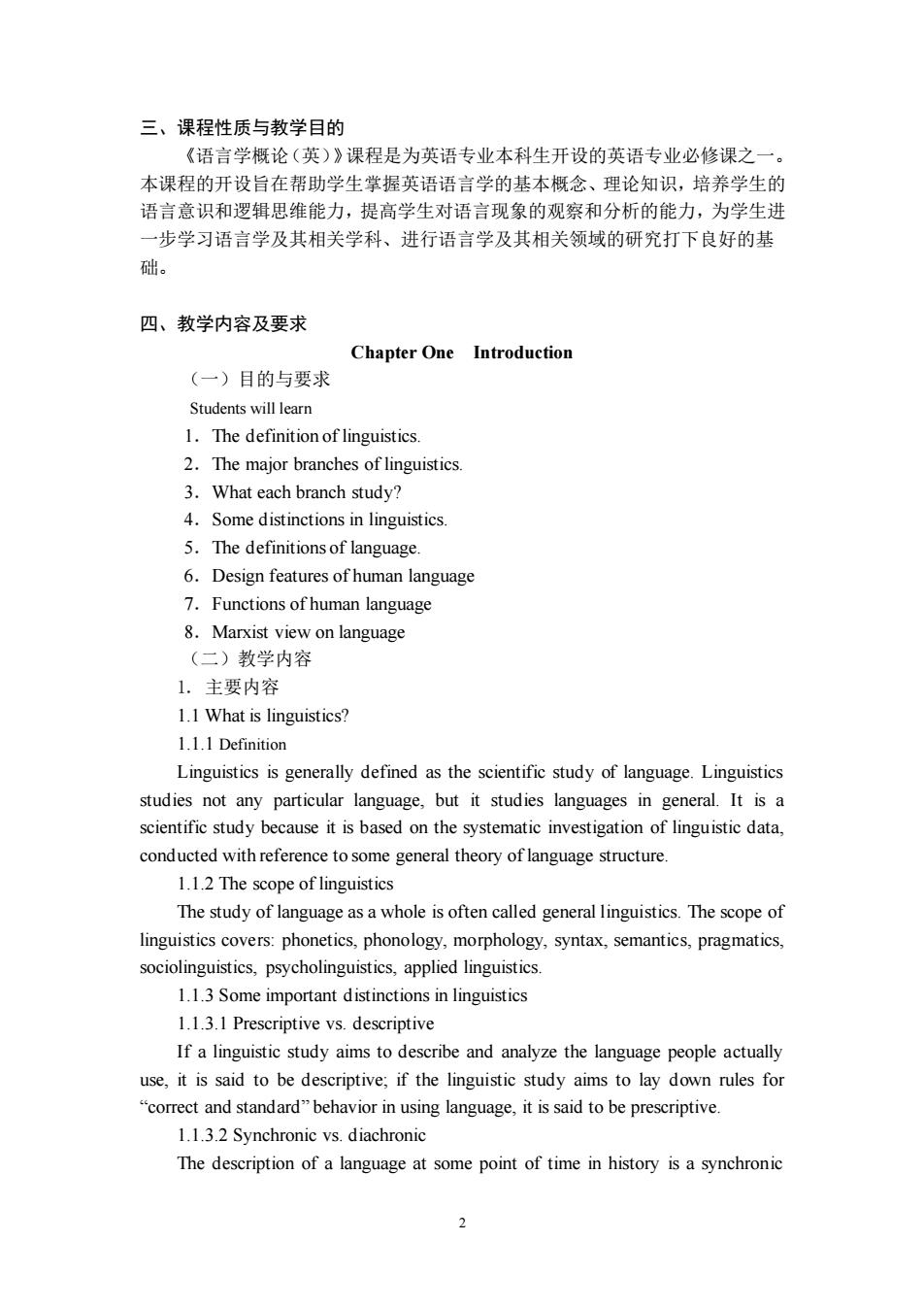
三、课程性质与教学目的 《语言学概论(英)》课程是为英语专业本科生开设的英语专业必修课之一。 本课程的开设旨在帮助学生掌握英语语言学的基本概念、理论知识,培养学生的 语言意识和逻辑思维能力,提高学生对语言现象的观察和分析的能力,为学生进 一步学习语言学及其相关学科、进行语言学及其相关领域的研究打下良好的基 础。 四、教学内容及要求 Chapter One Introduction (一)目的与要求 Students will learn 1.The definition of linguistics 2.The major branches of linguistics. 3.What each branch study? 4.Some distinctions in linguistics 5.The definitions of language. 6.Design features of human language 7.Functions of human language 8.Marxist view on language (二)教学内容 1.主要内容 1.1 What is linguistics? 1.1.1 Definition Linguistics is generally defined as the scientific study of language.Linguistics studies not any particular language,but it studies languages in general.It is a scientific study because it is based on the systematic investigation of linguistic data conducted with reference to some general theory of language structure. 1.1.2 The scope of linguistics The study of language as a whole is often called general linguistics.The scope of linguistics covers:phonetics,phonology,morphology,syntax,semantics,pragmatics. sociolinguistics,psycholinguistics,applied linguistics. 1.1.3 Some important distinctions in linguistics 1.1.3.1 Prescriptive vs.descriptive If a linguistic study aims to describe and analyze the language people actually use,it is said to be descriptive:if the linguistic study aims to lay down rules for correct and standard"behavior in using language,it is said to be prescriptive 1.1.3.2 Synchronic vs.diachronic The description of a language at some point of time in history is a synchronic 2
2 三、课程性质与教学目的 《语言学概论(英)》课程是为英语专业本科生开设的英语专业必修课之一。 本课程的开设旨在帮助学生掌握英语语言学的基本概念、理论知识,培养学生的 语言意识和逻辑思维能力,提高学生对语言现象的观察和分析的能力,为学生进 一步学习语言学及其相关学科、进行语言学及其相关领域的研究打下良好的基 础。 四、教学内容及要求 Chapter One Introduction (一)目的与要求 Students will learn 1.The definition of linguistics. 2.The major branches of linguistics. 3.What each branch study? 4.Some distinctions in linguistics. 5.The definitions of language. 6.Design features of human language 7.Functions of human language 8.Marxist view on language (二)教学内容 1. 主要内容 1.1 What is linguistics? 1.1.1 Definition Linguistics is generally defined as the scientific study of language. Linguistics studies not any particular language, but it studies languages in general. It is a scientific study because it is based on the systematic investigation of linguistic data, conducted with reference to some general theory of language structure. 1.1.2 The scope of linguistics The study of language as a whole is often called general linguistics. The scope of linguistics covers: phonetics, phonology, morphology, syntax, semantics, pragmatics, sociolinguistics, psycholinguistics, applied linguistics. 1.1.3 Some important distinctions in linguistics 1.1.3.1 Prescriptive vs. descriptive If a linguistic study aims to describe and analyze the language people actually use, it is said to be descriptive; if the linguistic study aims to lay down rules for “correct and standard” behavior in using language, it is said to be prescriptive. 1.1.3.2 Synchronic vs. diachronic The description of a language at some point of time in history is a synchronic
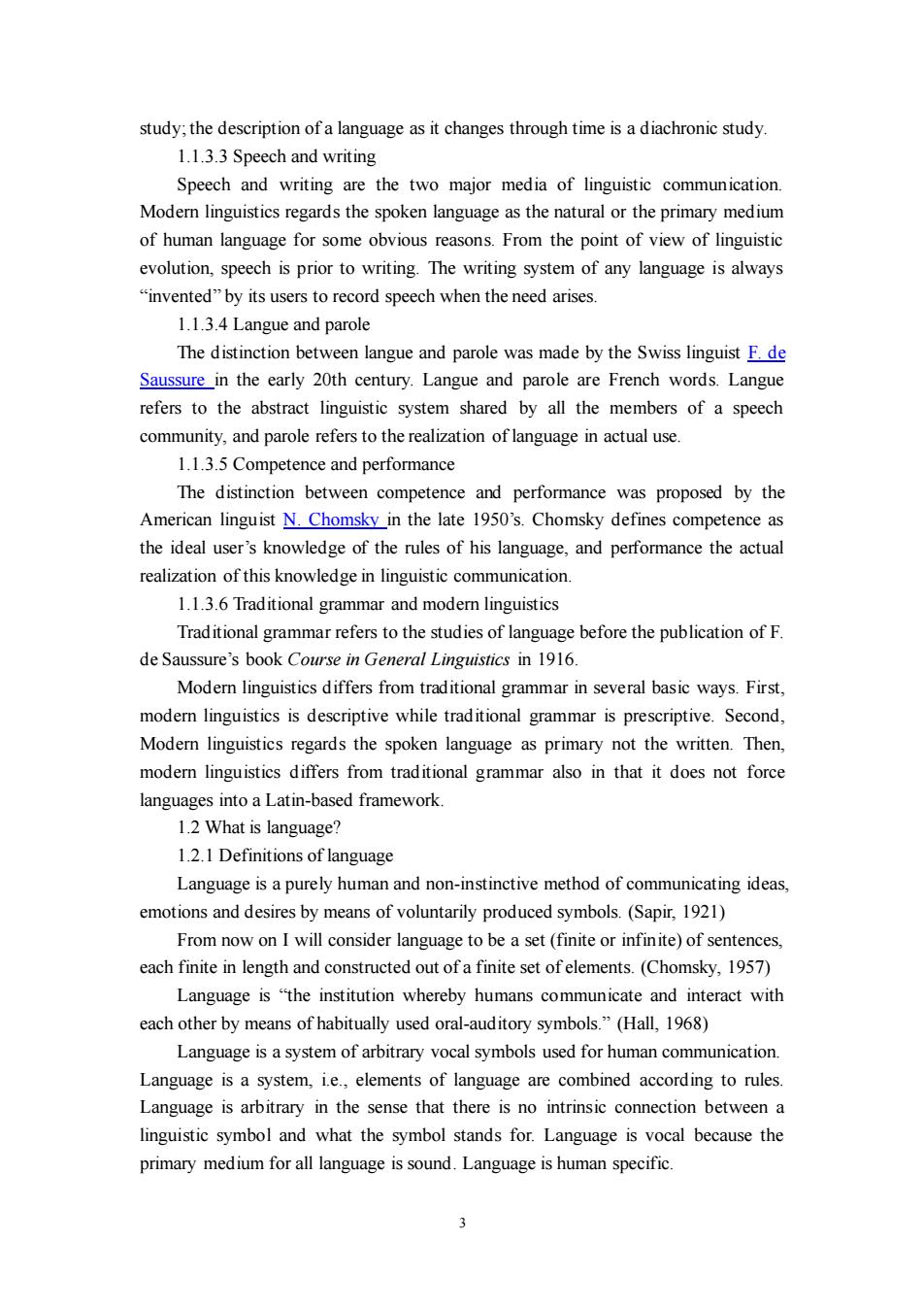
study:the description of a language as it changes through time is a diachronic study 1.1.3.3 Speech and writing Speech and writing are the two major media of linguistic communication Modern linguistics regards the spoken language as the natural or the primary medium of human language for some obvious reasons.From the point of view of linguistic evolution.speech is prior to writing.The writing system of any language is always "invented"by its users to record speech when the need arises. 1.1.3.4 Langue and parole The distinction between langue and parole was made by the Swiss linguist F.de Saussure in the early 20th century.Langue and parole are French words.Langue refers to the abstract linguistic system shared by all the members of a speech community,and parole refers to the realization of language in actual use. 1.1.3.5 Competence and performance The distinction between competence and performance was proposed by the American linguist N.Chomsky_in the late 1950's.Chomsky defines competence as the ideal user's knowledge of the rules of his language,and performance the actual realization of this knowledge in linguistic communication. 1.1.3.6Traditional grammar and moder linguistics Traditional grammar refers to the studies of language before the publication of F. de Saussure's book Course in General Linguistics in 1916 Modern linguistics differs from traditional grammar in several basic ways.First, modem linguistics is descriptive while traditional grammar is prescriptive.Second Modern linguistics regards the spoken language as primary not the written.Then, modern linguistics differs from traditional grammar also in that it does not force languages into a Latin-based framework. 1.2 What is language? 1.2.1 Definitions of language Language is a purely human and non-instinctive method of communicating ideas, emotions and desires by means of voluntarily produced symbols.(Sapir,1921) From now on I will consider language to be a set (finite or infinite)of sentences each finite in length and constructed out ofa finite set ofelements.(Chomsky,1957) Language is "the institution whereby humans communicate and interact with each other by means of habitually used oral-auditory symbols."(Hall,1968) Language is a system of arbitrary vocal symbols used for human communication. Language is a system,ie.,elements of language are combined according to rules Language is arbitrary in the sense that there is no intrinsic connection between a linguistic symbol and what the symbol stands for.Language is vocal because the primary medium for all language is sound.Language is human specific
3 study; the description of a language as it changes through time is a diachronic study. 1.1.3.3 Speech and writing Speech and writing are the two major media of linguistic communication. Modern linguistics regards the spoken language as the natural or the primary medium of human language for some obvious reasons. From the point of view of linguistic evolution, speech is prior to writing. The writing system of any language is always “invented” by its users to record speech when the need arises. 1.1.3.4 Langue and parole The distinction between langue and parole was made by the Swiss linguist F. de Saussure in the early 20th century. Langue and parole are French words. Langue refers to the abstract linguistic system shared by all the members of a speech community, and parole refers to the realization of language in actual use. 1.1.3.5 Competence and performance The distinction between competence and performance was proposed by the American linguist N. Chomsky in the late 1950’s. Chomsky defines competence as the ideal user’s knowledge of the rules of his language, and performance the actual realization of this knowledge in linguistic communication. 1.1.3.6 Traditional grammar and modern linguistics Traditional grammar refers to the studies of language before the publication of F. de Saussure’s book Course in General Linguistics in 1916. Modern linguistics differs from traditional grammar in several basic ways. First, modern linguistics is descriptive while traditional grammar is prescriptive. Second, Modern linguistics regards the spoken language as primary not the written. Then, modern linguistics differs from traditional grammar also in that it does not force languages into a Latin-based framework. 1.2 What is language? 1.2.1 Definitions of language Language is a purely human and non-instinctive method of communicating ideas, emotions and desires by means of voluntarily produced symbols. (Sapir, 1921) From now on I will consider language to be a set (finite or infinite) of sentences, each finite in length and constructed out of a finite set of elements. (Chomsky, 1957) Language is “the institution whereby humans communicate and interact with each other by means of habitually used oral-auditory symbols.” (Hall, 1968) Language is a system of arbitrary vocal symbols used for human communication. Language is a system, i.e., elements of language are combined according to rules. Language is arbitrary in the sense that there is no intrinsic connection between a linguistic symbol and what the symbol stands for. Language is vocal because the primary medium for all language is sound. Language is human specific
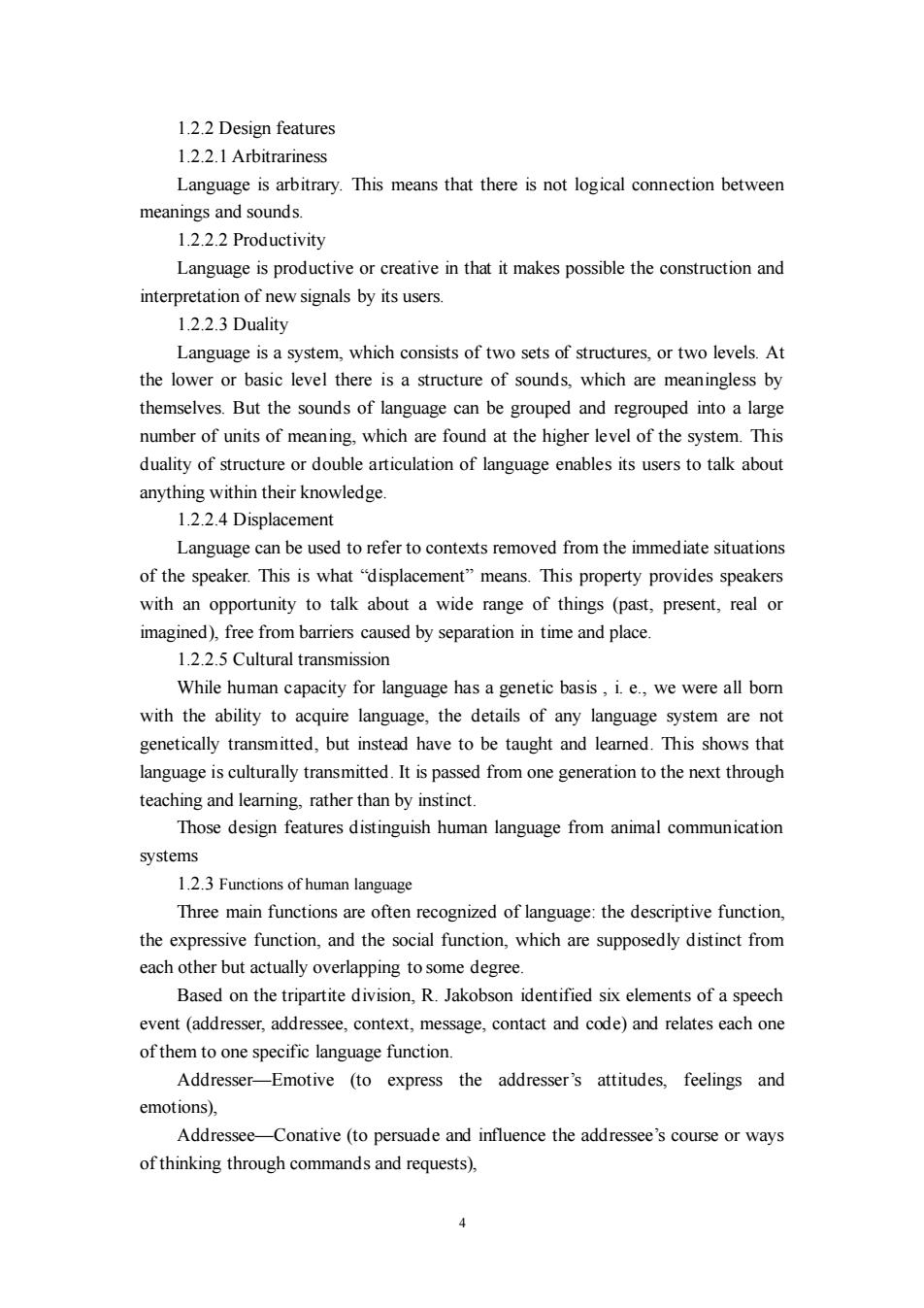
1.2.2 Design features 12 2 1 Arbitrariness Language is arbitrary.This means that there is not logical connection between meanings and sounds. 1.2.2.2 Productivity Language is productive or creative in that it makes possible the construction and interpretation of new signals by its users 1.2.2.3 Duality Language is a system,which consists of two sets of structures,or two levels.At the lower or basic level there is a structure of sounds,which are meaningless by themselves.But the sounds of language can be grouped and regrouped into a large number of units of meaning.which are found at the higher level of the system.This duality of structure or double articulation of language enables its users to talk about anything within their knowledge. 1.2.2.4 Displacement Language can be used to refer to contexts removed from the immediate situations of the speaker.This is what "displacement"means.This property provides speakers with an opportunity to talk about a wide range of things (past,present,real or imagined),free from barriers caused by separation in time and place 1.2.2.5 Cultural transmission While human capacity for language has a genetic basis,i.e.,we were all born with the ability to acquire language.the details of any language system are not genetically transmitted,but instead have to be taught and leamed.This shows that language is culturally transmitted.It is passed from one generation to the next through teaching and leaming.rather than by instinct. Those design features distinguish human language from animal communication systems 12.3 Functions of human language Three main functions are often recognized of language:the descriptive function, the expressive function,and the social function,which are supposedly distinct from each other but actually overlapping to some degree. Based on the tripartite division,R.Jakobson identified six elements of a speech event(addresser,addressee,context,message,contact and code)and relates each one ofthem to one specific language function. Addresser-Emotive (to express the addresser's attitudes,feelings and emotions). Addressee-Conative(to persuade and influence the addressee's course or ways of thinking through commands and requests)
4 1.2.2 Design features 1.2.2.1 Arbitrariness Language is arbitrary. This means that there is not logical connection between meanings and sounds. 1.2.2.2 Productivity Language is productive or creative in that it makes possible the construction and interpretation of new signals by its users. 1.2.2.3 Duality Language is a system, which consists of two sets of structures, or two levels. At the lower or basic level there is a structure of sounds, which are meaningless by themselves. But the sounds of language can be grouped and regrouped into a large number of units of meaning, which are found at the higher level of the system. This duality of structure or double articulation of language enables its users to talk about anything within their knowledge. 1.2.2.4 Displacement Language can be used to refer to contexts removed from the immediate situations of the speaker. This is what “displacement” means. This property provides speakers with an opportunity to talk about a wide range of things (past, present, real or imagined), free from barriers caused by separation in time and place. 1.2.2.5 Cultural transmission While human capacity for language has a genetic basis , i. e., we were all born with the ability to acquire language, the details of any language system are not genetically transmitted, but instead have to be taught and learned. This shows that language is culturally transmitted. It is passed from one generation to the next through teaching and learning, rather than by instinct. Those design features distinguish human language from animal communication systems 1.2.3 Functions of human language Three main functions are often recognized of language: the descriptive function, the expressive function, and the social function, which are supposedly distinct from each other but actually overlapping to some degree. Based on the tripartite division, R. Jakobson identified six elements of a speech event (addresser, addressee, context, message, contact and code) and relates each one of them to one specific language function. Addresser—Emotive (to express the addresser’s attitudes, feelings and emotions), Addressee—Conative (to persuade and influence the addressee’s course or ways of thinking through commands and requests)
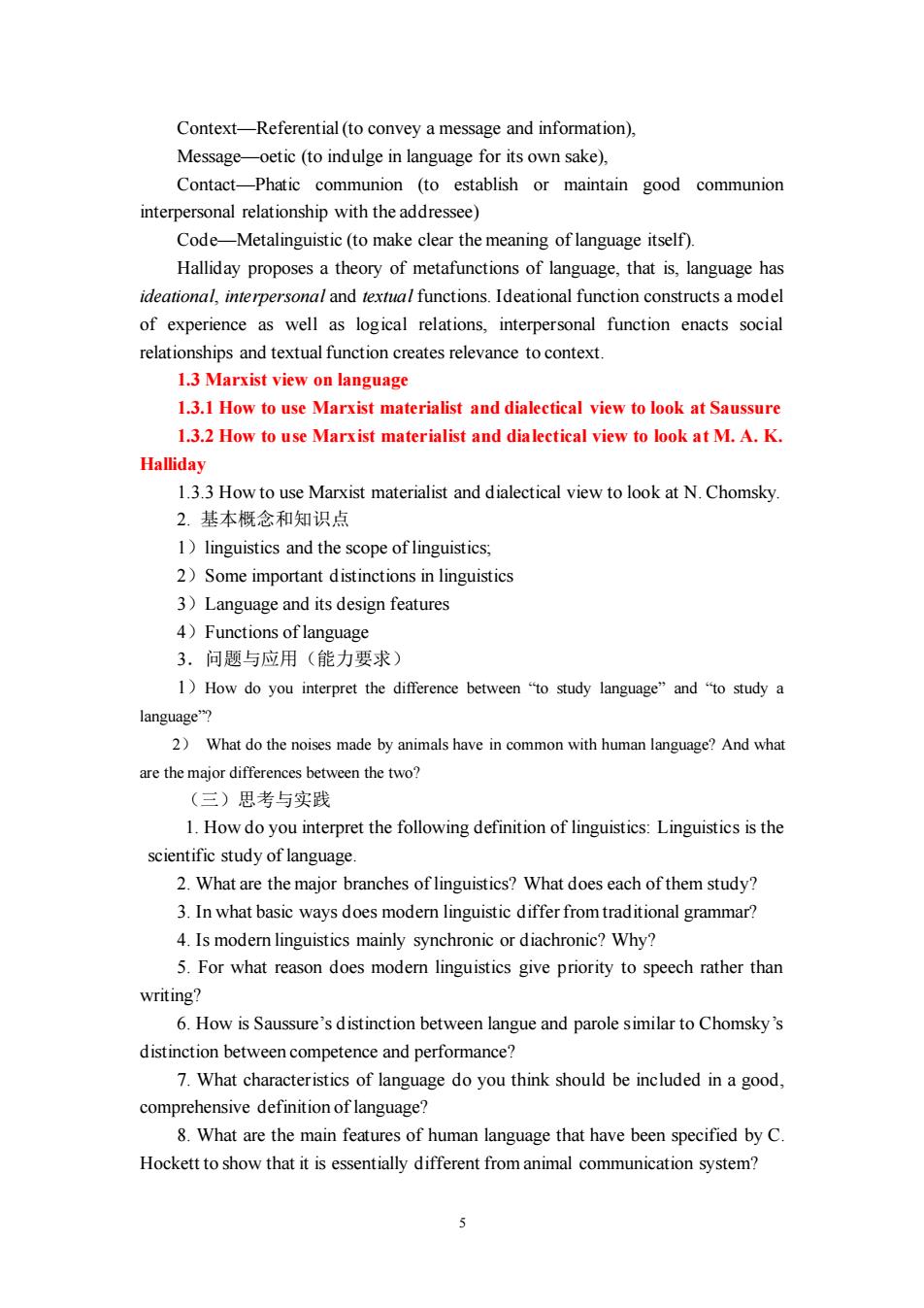
Context-Referential(to convey a message and information). Message-oetic (to indulge in language for its own sake), Contact-Phatic communion (to establish or maintain good communion interpersonal relationship with the addressee) Code-Metalinguistic (to make clear the meaning of language itself) Halliday proposes a theory of metafunctions of language,that is,language has ideational,interpersonal and textal functions.Ideational function constructs a model of experience as well as logical relations,interpersonal function enacts social relationships and textual function creates relevance to context. 1.3 Marxist view on language 1.3.1 How to use Marxist materialist and dialectical view to look at Saussure 1.3.2 How to use Marxist materialist and dialectical view to look at M.A.K. Halliday 1.3.3 How to use Marxist materialist and dialectical view to look at N.Chomsky 2.基本概念和知识点 1)linguistics and the scope of linguistics 2)Some important distinctions in linguistics 3)Language and its design features 4)Functions of language 3.问题与应用(能力要求》 1)How do you interpret the difference between "to study language"and "to study a language" 2)What do the noises made by animals have in common with human language?And what are the major differences between the two? (三)思考与实践 1.How do you interpret the following definition of linguistics:Linguistics is the scientific study of language. 2.What are the major branches of linguistics?What does each ofthem study? 3.In what basic ways does modem linguistic differ fromtraditional grammar? 4.Is modemn linguistics mainly synchronic or diachronic?Why? 5.For what reason does modem linguistics give priority to speech rather than writing? 6.How is Saussure's distinction between langue and parole similar to Chomsky's distinction between competence and performance? 7.What characteristics of language do you think should be included in a good. comprehensive definition of language? 8.What are the main features of human language that have been specified by C Hockett to show that it is essentially different from animal communication system?
5 Context—Referential (to convey a message and information), Message—oetic (to indulge in language for its own sake), Contact—Phatic communion (to establish or maintain good communion interpersonal relationship with the addressee) Code—Metalinguistic (to make clear the meaning of language itself). Halliday proposes a theory of metafunctions of language, that is, language has ideational, interpersonal and textual functions. Ideational function constructs a model of experience as well as logical relations, interpersonal function enacts social relationships and textual function creates relevance to context. 1.3 Marxist view on language 1.3.1 How to use Marxist materialist and dialectical view to look at Saussure 1.3.2 How to use Marxist materialist and dialectical view to look at M. A. K. Halliday 1.3.3 How to use Marxist materialist and dialectical view to look at N. Chomsky. 2. 基本概念和知识点 1)linguistics and the scope of linguistics; 2)Some important distinctions in linguistics 3)Language and its design features 4)Functions of language 3.问题与应用(能力要求) 1)How do you interpret the difference between “to study language” and “to study a language”? 2) What do the noises made by animals have in common with human language? And what are the major differences between the two? (三)思考与实践 1. How do you interpret the following definition of linguistics: Linguistics is the scientific study of language. 2. What are the major branches of linguistics? What does each of them study? 3. In what basic ways does modern linguistic differ from traditional grammar? 4. Is modern linguistics mainly synchronic or diachronic? Why? 5. For what reason does modern linguistics give priority to speech rather than writing? 6. How is Saussure’s distinction between langue and parole similar to Chomsky’s distinction between competence and performance? 7. What characteristics of language do you think should be included in a good, comprehensive definition of language? 8. What are the main features of human language that have been specified by C. Hockett to show that it is essentially different from animal communication system?

9.What are the major functions of language?Think of your own examples for illustration. (四)教学方法与手段 1.课堂讲授,课堂讨论,提问,回答问题,头脑风暴,调查研究等。 2.多媒体、网络辅助教学、电子教案。 Chapter Two Phonology (一)目的与要求 Students will leamn 1.The phonic medium of language 2.What phonetics is 3.Organs of speech 4.IPA:Orthographic representation of speech sounds-broad and narrow transcription (4-1 Introduction to Chinese Pinyin) 5.Classification of English speech sounds 6.What phonology is 7.Phone,phoneme,and allophone 8.Phonemic contrast,complementary distribution and minimal pair 9.Some rules in phonology 10.Suprasegmental features:stress.tone.intonaiton 10-1:syllable and tone in Chinese Students will be able to analyze the phonological structures and be able to distinguish an English word from non-English word.Students will also be able to know that different stress and intonation in English words and sentences may lead to different meaning (二)教学内容 1.主要内容 2.1 The phonic medium of language Speech and writing are the two media or substance used by natural languages as vehicles for communication.Language is first perceived through its sounds.Thus the study of sounds is of great importance in linguistics.The limited range of sound produced by humans through their speech organs and meaningful in human communication constitutes the phonic medium of language;and the individual sounds within this range are the speech sounds. 2.2Phontics 2.2.1 What is phonetics? Phonetics is defined as the study of the phonic medium of language;it is 6
6 9. What are the major functions of language? Think of your own examples for illustration. (四)教学方法与手段 1. 课堂讲授,课堂讨论,提问,回答问题,头脑风暴,调查研究等。 2. 多媒体、网络辅助教学、电子教案。 Chapter Two Phonology (一) 目的与要求 Students will learn: 1. The phonic medium of language 2. What phonetics is 3. Organs of speech 4. IPA: Orthographic representation of speech sounds—broad and narrow transcription (4-1 Introduction to Chinese Pinyin) 5. Classification of English speech sounds 6. What phonology is 7. Phone, phoneme, and allophone 8. Phonemic contrast, complementary distribution and minimal pair 9. Some rules in phonology 10. Suprasegmental features: stress, tone, intonaiton 10-1: syllable and tone in Chinese Students will be able to analyze the phonological structures and be able to distinguish an English word from non-English word. Students will also be able to know that different stress and intonation in English words and sentences may lead to different meaning. (二) 教学内容 1. 主要内容 2.1 The phonic medium of language Speech and writing are the two media or substance used by natural languages as vehicles for communication. Language is first perceived through its sounds. Thus the study of sounds is of great importance in linguistics. The limited range of sound produced by humans through their speech organs and meaningful in human communication constitutes the phonic medium of language; and the individual sounds within this range are the speech sounds. 2.2 Phontics 2.2.1 What is phonetics? Phonetics is defined as the study of the phonic medium of language; it is
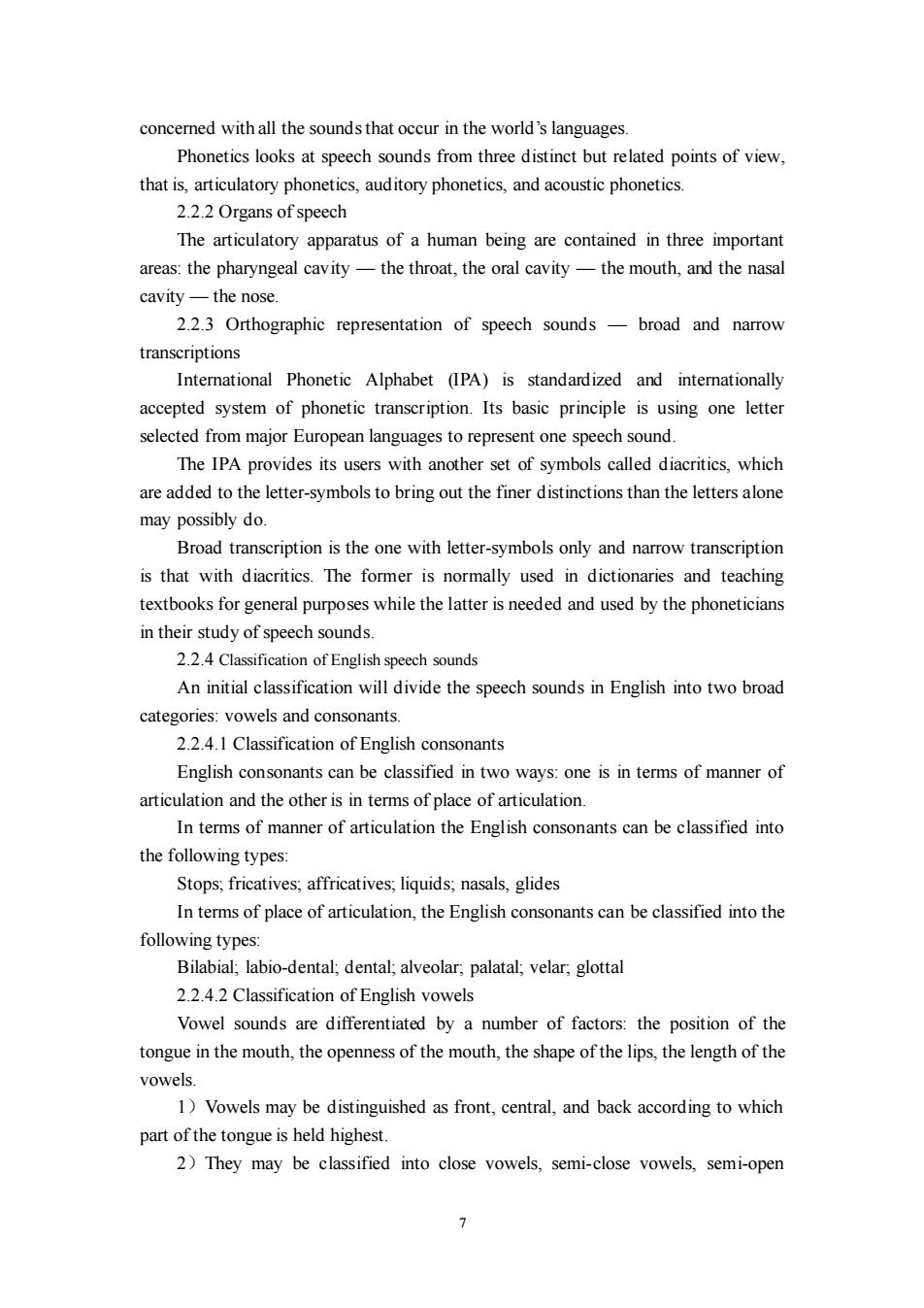
concemed with all the sounds that occur in the world's languages. Phonetics looks at speech sounds from three distinct but related points of view, that is,articulatory phonetics,auditory phonetics,and acoustic phonetics 2.2.2 Organs of speech The articulatory apparatus of a human being are contained in three important areas:the pharyngeal cavity-the throat,the oral cavity-the mouth,and the nasal cavity-the nose 2.2.3 Orthographic representation of speech sounds-broad and narrow transcriptions International Phonetic Alphabet (PA)is standardized and internationally accepted system of phonetic transcription.Its basic principle is using one letter selected from major European languages to represent one speech sound. The IPA provides its users with another set of symbols called diacritics.which are added to the letter-symbols to bring out the finer distinctions than the letters alone may possibly do. Broad transcription is the one with letter-symbols only and narrow transcription is that with diacritics.The former is normally used in dictionaries and teaching textbooks for general purposes while the latter is needed and used by the phoneticians in their study of speech sounds 2.2 Classification of English speech sounds An initial classification will divide the speech sounds in English into two broad categories:vowels and consonants 2.2.4.1 Classification of English consonants English consonants can be classified in two ways:one is in terms of manner of articulation and the other is in terms of place of articulation. In terms of manner of articulation the English consonants can be classified into the following types: Stops,fricatives,affricatives,liquids,nasals,glides In terms of place of articulation,the English consonants can be classified into the following types: Bilabial;labio-dental,dental,alveolar,palatal;velar,glottal 2.2.4.2 Classification of English vowels Vowel sounds are differentiated by a number of factors:the position of the tongue in the mouth,the openness of the mouth,the shape of the lips,the length of the vowels. 1)Vowels may be distinguished as front,central,and back according to which part of the tongue is held highest. 2)They may be classified into close vowels,semi-close vowels,semi-open
7 concerned with all the sounds that occur in the world’s languages. Phonetics looks at speech sounds from three distinct but related points of view, that is, articulatory phonetics, auditory phonetics, and acoustic phonetics. 2.2.2 Organs of speech The articulatory apparatus of a human being are contained in three important areas: the pharyngeal cavity — the throat, the oral cavity — the mouth, and the nasal cavity — the nose. 2.2.3 Orthographic representation of speech sounds — broad and narrow transcriptions International Phonetic Alphabet (IPA) is standardized and internationally accepted system of phonetic transcription. Its basic principle is using one letter selected from major European languages to represent one speech sound. The IPA provides its users with another set of symbols called diacritics, which are added to the letter-symbols to bring out the finer distinctions than the letters alone may possibly do. Broad transcription is the one with letter-symbols only and narrow transcription is that with diacritics. The former is normally used in dictionaries and teaching textbooks for general purposes while the latter is needed and used by the phoneticians in their study of speech sounds. 2.2.4 Classification of English speech sounds An initial classification will divide the speech sounds in English into two broad categories: vowels and consonants. 2.2.4.1 Classification of English consonants English consonants can be classified in two ways: one is in terms of manner of articulation and the other is in terms of place of articulation. In terms of manner of articulation the English consonants can be classified into the following types: Stops; fricatives; affricatives; liquids; nasals, glides In terms of place of articulation, the English consonants can be classified into the following types: Bilabial; labio-dental; dental; alveolar; palatal; velar; glottal 2.2.4.2 Classification of English vowels Vowel sounds are differentiated by a number of factors: the position of the tongue in the mouth, the openness of the mouth, the shape of the lips, the length of the vowels. 1)Vowels may be distinguished as front, central, and back according to which part of the tongue is held highest. 2)They may be classified into close vowels, semi-close vowels, semi-open

vowels and open vowels according the openness of the mouth. 3)They may be classified into unrounded vowels and rounded vowels according to the shape of the lips. 4)They may be classified into long and short vowels according to the length of the sound. 2.3 Phonology 2.3.1 Phonology and phonetics Phonetics is concerned with the general nature of speech sound while phonology aims to discover how speech sounds in a language form patterns and how these sounds are used to convey meaning in linguistic communication. 2.3.2 Phone,phoneme,and allophone A phone is a phonetic unit or segment.The speech sounds we hear and produce during linguistic communication are all phones. A phoneme is a phonological unit;it is a unit that is of distinctive value.It is an abstract unit.It is not any particular sound,but rather it is represented or realized by a certain phone in a certain phonetic context. The different phones which can represent a phoneme in different phonetic environments are called the allophones of that phoneme.For example,the phoneme// in English can be realized as dark []clear [l],etc.which are allophones of the phoneme / 2.3.3 Phonemic contrast,complementary distribution,and minimal pair If the phonetically similar sounds are two distinctive phonemes,they are said to form a phonemic contrast,e.g./p/and /b/in /pit/and /bit/. If they are allophones of the same phoneme,then they do not distinguish meaning,but complement each other in distribution.For instance,the clear/l/always occurs before a vowel while the dark always occurs between a vowel and a consonant.or at the end of a word.So the allophones are said to be in complementary distribution. When two different forms are identical in every way except for one sound segment which occurs in the same place in the strings,the two sound combinations are said to form a minimal pair.So in English,pil/and bil/are a minimal pair 2.3.4 Some rules in phonology 2.3.4.1 Sequential rules Sequential rules are rules that govern the combination of sound in a particular language. 2.3.42 Assimilation rule The assimilation rule assimilates one sound to another by"copying"a feature of a sequential phoneme,thus making the two phones similar
8 vowels and open vowels according the openness of the mouth. 3)They may be classified into unrounded vowels and rounded vowels according to the shape of the lips. 4)They may be classified into long and short vowels according to the length of the sound. 2.3 Phonology 2.3.1 Phonology and phonetics Phonetics is concerned with the general nature of speech sound while phonology aims to discover how speech sounds in a language form patterns and how these sounds are used to convey meaning in linguistic communication. 2.3.2 Phone, phoneme, and allophone A phone is a phonetic unit or segment. The speech sounds we hear and produce during linguistic communication are all phones. A phoneme is a phonological unit; it is a unit that is of distinctive value. It is an abstract unit. It is not any particular sound, but rather it is represented or realized by a certain phone in a certain phonetic context. The different phones which can represent a phoneme in different phonetic environments are called the allophones of that phoneme. For example, the phoneme /l/ in English can be realized as dark [ɫ], clear [l], etc. which are allophones of the phoneme /l/. 2.3.3 Phonemic contrast, complementary distribution, and minimal pair If the phonetically similar sounds are two distinctive phonemes, they are said to form a phonemic contrast, e.g. /p/ and /b/ in /pɪt/ and /bɪt/. If they are allophones of the same phoneme, then they do not distinguish meaning, but complement each other in distribution. For instance, the clear /l/ always occurs before a vowel while the dark /ɫ/ always occurs between a vowel and a consonant, or at the end of a word. So the allophones are said to be in complementary distribution. When two different forms are identical in every way except for one sound segment which occurs in the same place in the strings, the two sound combinations are said to form a minimal pair. So in English, pill and bill are a minimal pair. 2.3.4 Some rules in phonology 2.3.4.1 Sequential rules Sequential rules are rules that govern the combination of sound in a particular language. 2.3.4.2 Assimilation rule The assimilation rule assimilates one sound to another by “copying” a feature of a sequential phoneme, thus making the two phones similar
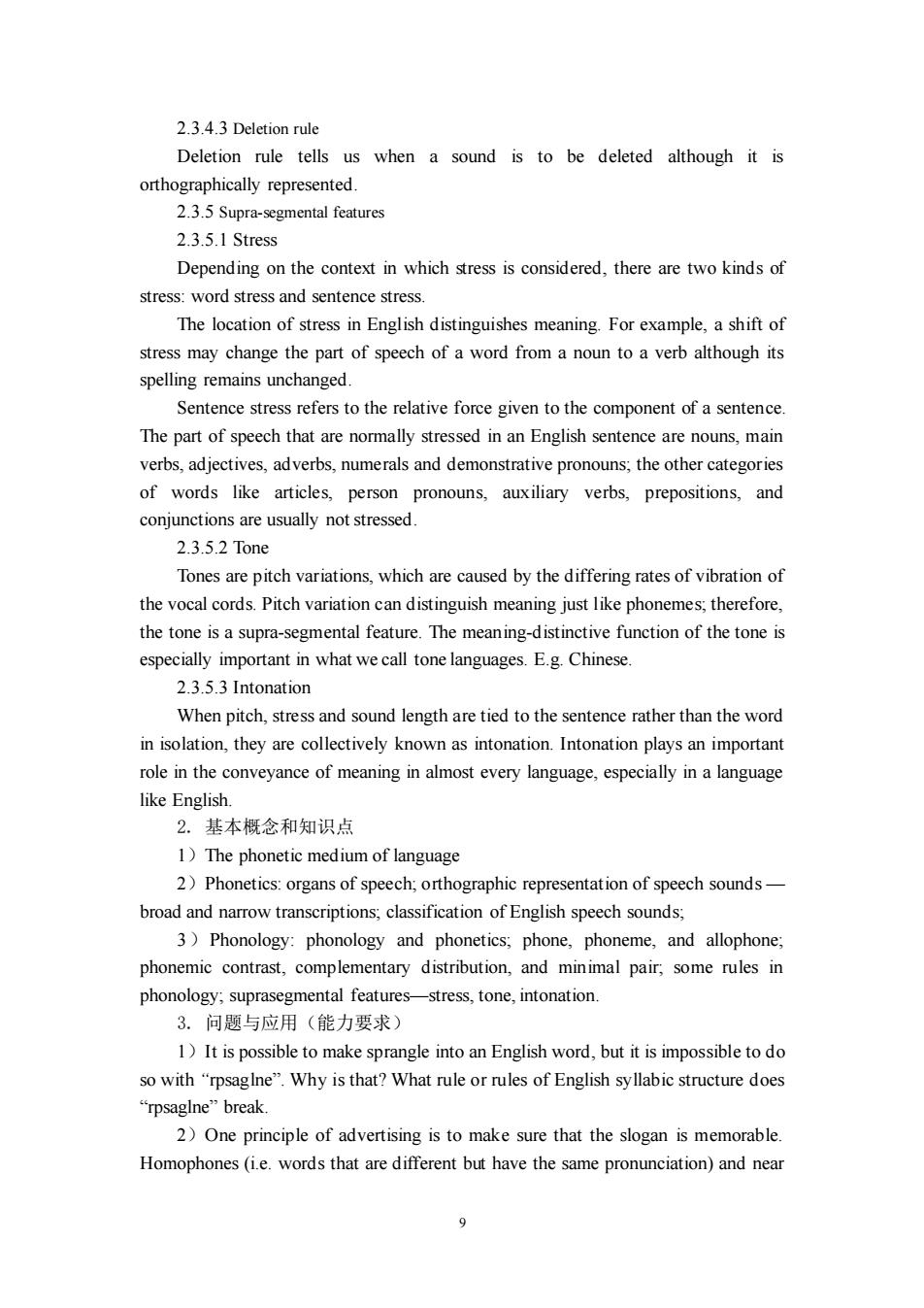
2.3.4.3 Deletion rule Deletion rule tells us when a sound is to be deleted although it is orthographically represented. 2.3.5 Supra-segmental features 2.3.5.1Stress Depending on the context in which stress is considered,there are two kinds of stress:word stress and sentence stress. The location of stress in English distinguishes meaning.For example,a shift of stress may change the part of speech of a word from a noun to a verb although its spelling remains unchanged. Sentence stress refers to the relative force given to the component of a sentence The part of speech that are normally stressed in an English sentence are nouns.main verbs,adjectives,adverbs,numerals and demonstrative pronouns,the other categories of words like articles,person pronouns,auxiliary verbs,prepositions,and conjunctions are usually not stressed. 2.3.52Tone Tones are pitch variations,which are caused by the differing rates of vibration of the vocal cords.Pitch variation can distinguish meaning just like phonemes,therefore the tone is a supra-segmental feature.The meaning-distinctive function of the tone is especially important in what wecall tone languages.E.g Chinese 2.3.5.3 Intonation When pitch,stress and sound length are tied to the sentence rather than the word in isolation,they are collectively known as intonation.Intonation plays an important role in the conveyance of meaning in almost every language,especially in a language like English. 2.基本概念和知识点 1)The phonetic medium of language 2)Phonetics:organs of speech;orthographic representation of speech sounds- broad and narrow transcriptions,classification of English speech sounds, 3)Phonology:phonology and phonetics,phone,phoneme,and allophone, phonemic contrast,complementary distribution,and minimal pair,some rules in phonology;suprasegmental features-stress,tone,intonation. 3.问题与应用(能力要求) 1)It is possible to make sprangle into an English word,but it is impossible to do so with"rpsaglne".Why is that?What rule or rules of English syllabic structure does "rpsaglne"break. 2)One principle of advertising is to make sure that the slogan is memorable Homophones(ie.words that are different but have the same pronunciation)and near
9 2.3.4.3 Deletion rule Deletion rule tells us when a sound is to be deleted although it is orthographically represented. 2.3.5 Supra-segmental features 2.3.5.1 Stress Depending on the context in which stress is considered, there are two kinds of stress: word stress and sentence stress. The location of stress in English distinguishes meaning. For example, a shift of stress may change the part of speech of a word from a noun to a verb although its spelling remains unchanged. Sentence stress refers to the relative force given to the component of a sentence. The part of speech that are normally stressed in an English sentence are nouns, main verbs, adjectives, adverbs, numerals and demonstrative pronouns; the other categories of words like articles, person pronouns, auxiliary verbs, prepositions, and conjunctions are usually not stressed. 2.3.5.2 Tone Tones are pitch variations, which are caused by the differing rates of vibration of the vocal cords. Pitch variation can distinguish meaning just like phonemes; therefore, the tone is a supra-segmental feature. The meaning-distinctive function of the tone is especially important in what we call tone languages. E.g. Chinese. 2.3.5.3 Intonation When pitch, stress and sound length are tied to the sentence rather than the word in isolation, they are collectively known as intonation. Intonation plays an important role in the conveyance of meaning in almost every language, especially in a language like English. 2. 基本概念和知识点 1)The phonetic medium of language 2)Phonetics: organs of speech; orthographic representation of speech sounds — broad and narrow transcriptions; classification of English speech sounds; 3)Phonology: phonology and phonetics; phone, phoneme, and allophone; phonemic contrast, complementary distribution, and minimal pair; some rules in phonology; suprasegmental features—stress, tone, intonation. 3. 问题与应用(能力要求) 1)It is possible to make sprangle into an English word, but it is impossible to do so with “rpsaglne”. Why is that? What rule or rules of English syllabic structure does “rpsaglne” break. 2)One principle of advertising is to make sure that the slogan is memorable. Homophones (i.e. words that are different but have the same pronunciation) and near
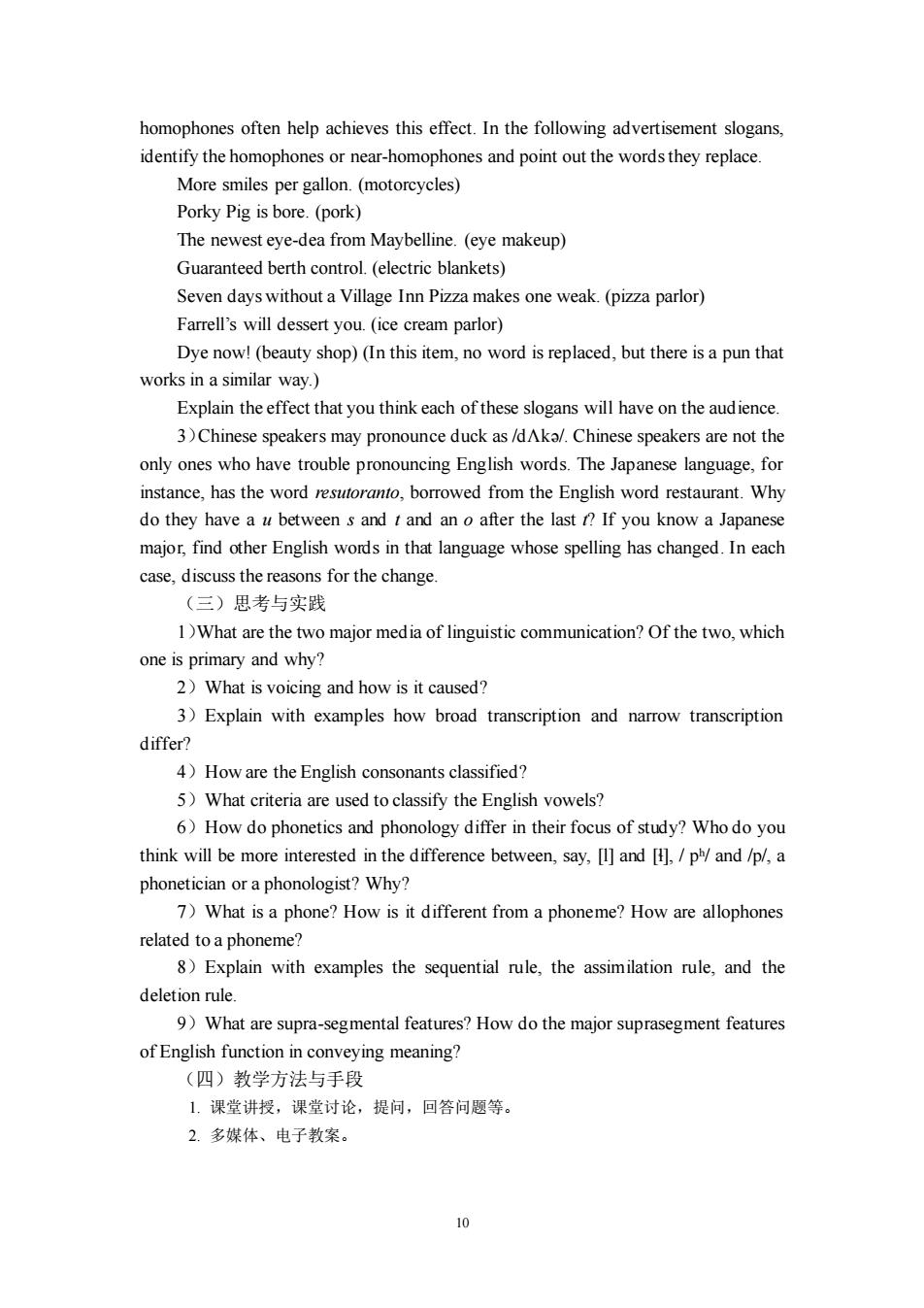
homophones often help achieves this effect.In the following advertisement slogans identify the homophones or near-homophones and point out the words they replace. More smiles per gallon.(motorcycles) Porky Pig is bore.(pork) The newest eye-dea from Maybelline.(eye makeup) Guaranteed berth control.(electric blankets) Seven days without a Village Inn Pizza makes one weak.(pizza parlor) Farrell's will dessert you.(ice cream parlor) Dye now!(beauty shop)(In this item,no word is replaced,but there is a pun that works in a similar way.) Explain the effect that you think each of these slogans will have on the audience. 3)Chinese speakers may pronounce duck as/dAka/.Chinese speakers are not the only ones who have trouble pronouncing English words.The Japanese language,for instance,has the word resuoranto,borrowed from the English word restaurant.Why do they have a u between s and t and an o after the last ?If you know a Japanese major,find other English words in that language whose spelling has changed.In each case.discuss the reasons for the change (三)思若与实践 1)What are the two major media of linguistic communication?Of the two,which one is primary and why? 2)What is voicing and how is it caused? 3)Explain with examples how broad transcription and narrow transcription differ? 4How are the English consonants classified? 5)What criteria are used to classify the English vowels? 6)How do phonetics and phonology differ in their focus of study?Who do you think will be more interested in the difference between,say,[l]and []ph/and /p/,a phonetician or a phonologist?Why? 7)What is a phone?How is it different from a phoneme?How are allophones related toa phoneme? 8)Explain with examples the sequential rule,the assimilation rule,and the 9What are supra-segmental features?How do the major suprasegment features of English function in conveying meaning? (四)教学方法与手段 1.课堂讲授,课堂讨论,提问,回答问题等 2.多媒体、电子教案
10 homophones often help achieves this effect. In the following advertisement slogans, identify the homophones or near-homophones and point out the words they replace. More smiles per gallon. (motorcycles) Porky Pig is bore. (pork) The newest eye-dea from Maybelline. (eye makeup) Guaranteed berth control. (electric blankets) Seven days without a Village Inn Pizza makes one weak. (pizza parlor) Farrell’s will dessert you. (ice cream parlor) Dye now! (beauty shop) (In this item, no word is replaced, but there is a pun that works in a similar way.) Explain the effect that you think each of these slogans will have on the audience. 3)Chinese speakers may pronounce duck as /dΛkə/. Chinese speakers are not the only ones who have trouble pronouncing English words. The Japanese language, for instance, has the word resutoranto, borrowed from the English word restaurant. Why do they have a u between s and t and an o after the last t? If you know a Japanese major, find other English words in that language whose spelling has changed. In each case, discuss the reasons for the change. (三)思考与实践 1)What are the two major media of linguistic communication? Of the two, which one is primary and why? 2)What is voicing and how is it caused? 3)Explain with examples how broad transcription and narrow transcription differ? 4)How are the English consonants classified? 5)What criteria are used to classify the English vowels? 6)How do phonetics and phonology differ in their focus of study? Who do you think will be more interested in the difference between, say, [l] and [ɬ], / pʰ/ and /p/, a phonetician or a phonologist? Why? 7)What is a phone? How is it different from a phoneme? How are allophones related to a phoneme? 8)Explain with examples the sequential rule, the assimilation rule, and the deletion rule. 9)What are supra-segmental features? How do the major suprasegment features of English function in conveying meaning? (四)教学方法与手段 1. 课堂讲授,课堂讨论,提问,回答问题等。 2. 多媒体、电子教案